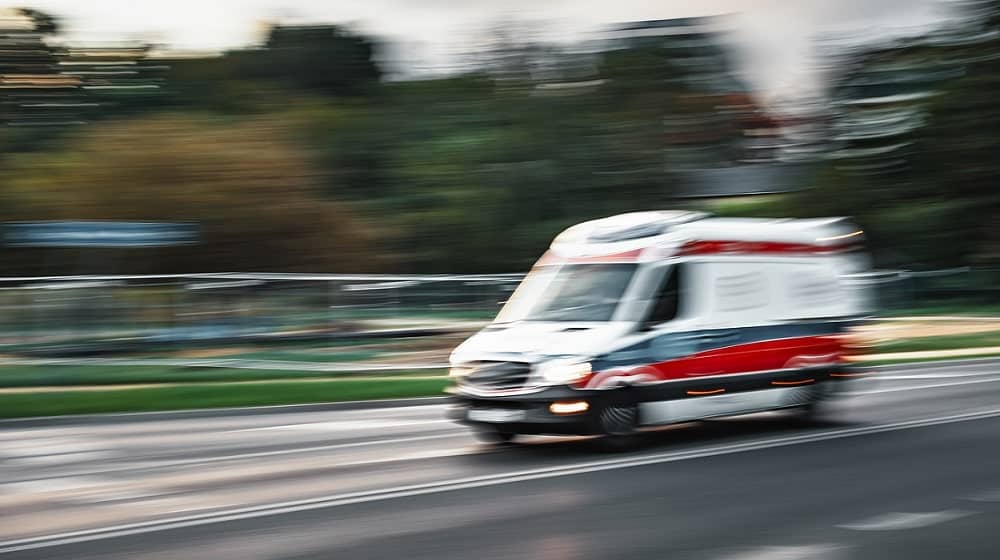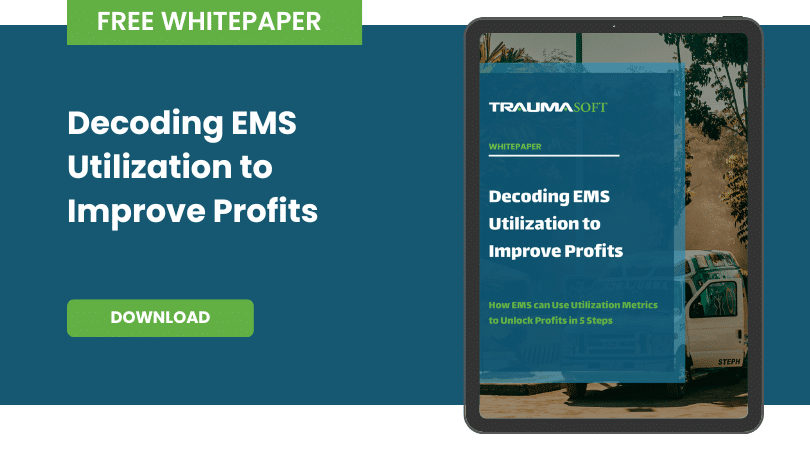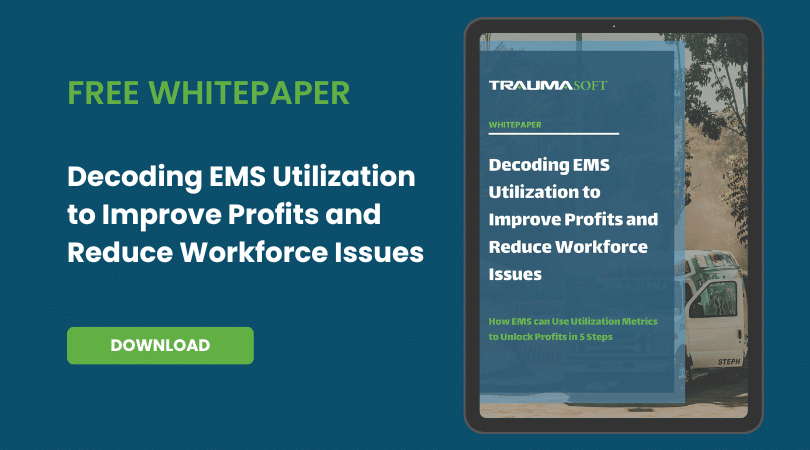
If you’re running an Emergency Medical Service (EMS) business and want to increase your profitability, then this article is for you.
As a provider of all-in-one Emergency Medical Services (EMS) management software, Traumasoft understands how tough it is for EMS organizations to increase profitability. With 12+ years of experience working with 200+ EMS organizations, we’ve observed that profitable EMS organizations focus on one key metric: Utilization Rate, which includes Unit Hour Utilization (UHU).
Why is this metric so important to profitability? In short, it’s because it identifies where you can operate more efficiently so you can put your resources to their best use.
As you’ll find out in this article, simply reporting on the key metric is half the battle. The other half is investigating and making operational adjustments and improvements to increase your overall utilization rate.
To this day, we still encounter EMS organizations that don’t measure Utilization Rate at all. Let’s start with a brief definition.
What is Utilization Rate and Unit Hour Utilization (UHU)?
In short, as the name suggests, Utilization Rate tells you how well your resources are “utilized” or used.
Unit Hour Utilization (UHU) is most commonly used to measure how well your ambulance(s) and its crews are being utilized during their shift.
UHU by Number of Transports
One way to come up with UHU is to divide the number of ambulance transports by the number of hours the ambulance and its crews are on shift. Fitch & Associates have done extensive research on this topic. In their article on ems1.com, they correctly stated that the higher the ratio, the more productive your ambulance and its crews are.
Here is an example. Suppose you have 1 ambulance on a 12-hour shift that made 6 transports. Your UHU is 6/12, or 0.5, for that 12-hour shift (6 transports divided by 12 hours).
If you’re focused on profitability, you should focus on this metric because you are paid per transport.
UHU by Hours Utilized
Another method is to calculate the number of hours the ambulance is being utilized instead of the number of transports. Using the same example above, if an ambulance on a 12-hour shift was used for 8 hours, then the UHU would be 0.67 (8 hours divided by 12-hour shift). Meaning, the ambulance was used two-thirds of the time during its shift.
If your units are being fully utilized by hours, but you’re only getting paid so much, then you may be servicing distant and unprofitable trips. Investigate which geographical areas those trips were made to and consider cutting service in those areas.
UHU Ratio: No General Consensus & Limited Measurement
According to Fitch & Associates, there is no general consensus regarding the ideal UHU ratio. We concur with that sentiment for two reasons:
- Organizations responding to emergencies differ from non-emergency medical transport companies.
- Organizations operating in different geographical zones can have a huge gap in transport time.
UHU only captures how well transportations are utilized. It does not capture how optimally your OTHER resources are being utilized. That is where Utilization Rate comes in. It expands the way UHU is measured on other resources within an EMS organization. Below are some examples.
Using Utilization Rate on a Micro and Macro Level to Increase Profitability
Below are five examples of how Utilization Rate was used to increase profitability, based on our interactions and experience working with customers.
Are ALL Ambulances Properly Utilized?
ABLE Medical Transport uses Traumasoft to monitor each ambulance’s utilization rate by tracking their mileage and hours utilized. When they began tracking, they found that whenever they purchase a new ambulance, the mileage and utilization rate of the new ambulance skyrockets. This is understandable because crew members love new rides (don’t we all). But that created a problem – the mileage, wear and tear on new ambulances quickly exceeded comparable metrics for older ambulances in just a few months. As a result, major maintenance expenditures were required much sooner than budgeted, putting a strain on cash flow.
Their solution was to use Traumasoft’s fleet maintenance to prevent these ambulances from being over-dispatched in the first place. This has enabled the longevity of their fleet and their bottom line.
How Many Dispatch Calls Can Your Staff Handle?
At NORCAL Ambulance, they measured the utilization of dispatchers, which considers the number of ambulances a dispatcher could handle at any given time. Those who could handle more were labeled “rockstars” primarily due to their experience. Because their business was poised to double in size, they needed a solution that enabled all their dispatchers to become “rockstars”.
They selected Traumasoft’s CAD because of its ease of use. As a result, they were able to dispatch 300-400% more efficiently, enabling their business to grow without adding headcount to their dispatch unit.
Are You Paying Staff for Unnecessary Idle Time?
Another customer suspected something awry in crew member utilization, but wasn’t able to pinpoint the problem. After drilling down into crew utilization using Traumasoft’s scheduling module, he discovered that certain crew members were clocking-in long before their shifts started and were just hanging around idly while getting paid.
Using Traumasoft’s employee scheduling features, the owner solved this problem by creating custom rules so crew members could not clock-in before their shifts. This reduced idle pay and helped increase their profitability.
Which Geographical Regions are Operating at a Loss?
When you’re able to see both revenue and utilization rate by call and ambulance, you might notice this – on certain days, an ambulance is fully utilized but generated far less revenue than usual. NORCAL Ambulance was faced with this problem. When they investigated further, they noticed that there were certain geographical regions that they were consistently operating at a loss. A tough decision was made to stop servicing unprofitable areas so they could cut their losses.
Which Stations are Most Profitable?
If you have multiple stations, you can see which ones are running more efficiently based on their UHU level. For example, if one station with 10 ambulances running 24 hours a day transported 120 patients, their UHU is 120/240, or 0.5. (120 transports divided by 10 ambulances at 24 hours). Compare this metric by station and you’ll find which one is better utilized. Further, you can cross reference this with revenue by station, then you can investigate and uncover what actions are needed to improve profitability of certain locations. At the very least, we recommend setting a minimum UHU level for each station so profitability can be sustained.
“That’s easy. Just get the Utilization Report.” Not So Fast…
If you think everything described above is simple, then I’m sorry to disappoint you. Utilization Rate is known to many. Yet, few are able to achieve the profitability they desire. Here’s why:
Generating Timely Reports Using Reliable Data
The first hurdle you have to jump through is to generate a report that you can use in a timely manner. If you’re still doing everything on pen and paper, then generating a report will take quite some time, often rendering it outdated.
If you’ve adopted a digital solution and you’re not using an integrated, all-in-one EMS management system, then you can have an issue of data integrity. Chances are, you have to export reports from multiple software products and mix and match those reports together, perhaps one from CAD, another from scheduling, and another from billing. If data doesn’t match, you’ll be forced to reconcile, making the report even more time-consuming to generate than if you used pen and paper.
Drilling Down to the Problem
Once you’ve generated a report, the next step is to pinpoint where the problem is. This was how ABLE Medical Transport was able to identify that new ambulances were being over-utilized, and how another customer was able to identify employees who were clocking-in early and receiving idle pay.
If your EMS software lacks the capability to drill-down on potential issues, the investigation process could be similar to finding a needle in a haystack, and the same problems will continue to eat away at your profits.
Implementing a Solution
When you’ve identified the problem, the next step is to implement a solution. For some, this is the hardest step. Sometimes an employee will just continue to clock-in early despite your warnings. Other times, your dispatchers simply can’t reach that “rockstar” level.
That is why you need to have a robust and user-friendly system in place to help you. Traumasoft was built to help EMS organizations operate profitably using a streamlined, all-in-one software solution that’s easy-to-use.
Conclusion
Throughout the years working with our customers, we observed that profitable EMS organizations used Utilization Rate as a key metric for business performance. However, reporting on that metric to increase profitability is not an easy feat nor a task that’s typically completed in a few days. As you may have experienced, profitability is a process of finding inefficiencies in the remote corners of your business and fixing them. Then, little by little, your profitability can add up to a noticeable savings.
If you’re looking to increase profitability and efficiency of your business, but find the process daunting, Traumasoft can make it easier for you. Contact us now to see how we can help.

